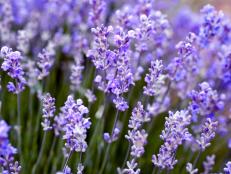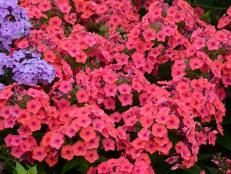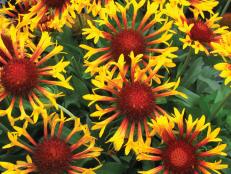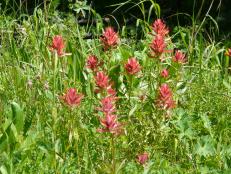Planting and Growing Yarrow
Whether you want drought tolerance, pollinator friendly or long lasting color, perennial yarrow can deliver. It also looks great in a vase. Learn about growing yarrow.
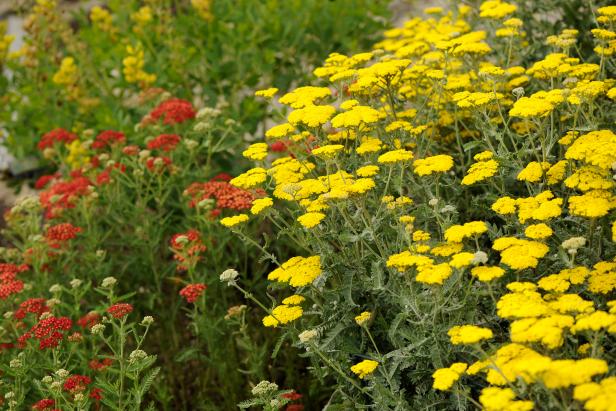
PerennialResource.com
'Moonshine' yarrow boasts lemon yellow blooms atop plants that reach 12 to 24 inches tall. If your yard is plagued with droughty, lean or sandy soil, this is the bloomer for you. It's hardy in Zones 3 to 8.
Tap into the native-inspired beauty of yarrow. A common wildflower, yarrow (Achillea millefolium) has transitioned artfully from meadows and roadsides to the perennial garden. Plant breeders have capitalized on yarrow's ability to crossbreed, creating a host of yarrow varieties and yarrow colors. All of these hardy bloomers share the common traits of low maintenance, drought tolerance and pest-free personalities.
Planting yarrow means giving your garden a shot of easy-care color. Common yarrow (Achillea millefolium) and fernleaf or yellow yarrow (Achillea filipendulina) bring summer-long blooms to garden beds and borders. Planting yarrow is an easy chore — even finding the just-right spot isn't difficult. Growing yarrow is equally simple. Plants are fuss-free and undemanding.
20 Flowers for a Cutting Garden
Plant these flowers —including yarrow — in your garden to yield endless vases filled with beautiful blooms.
Planting Yarrow
Choose a location in full sun for planting yarrow. Plants can survive in a part-sun location, but will open fewer flowers. Yarrow thrives in full sun and high heat. Plants don't hold up particularly well in high heat coupled with high humidity. The combination tends to cause plants to melt away in the heart of summer.
Yarrow blossoms stand atop tall stems that last for a long time. These stems hover above a clump of fern-like leaves, making them vulnerable to strong winds. Planting yarrow in a somewhat sheltered location protects the flower stems.
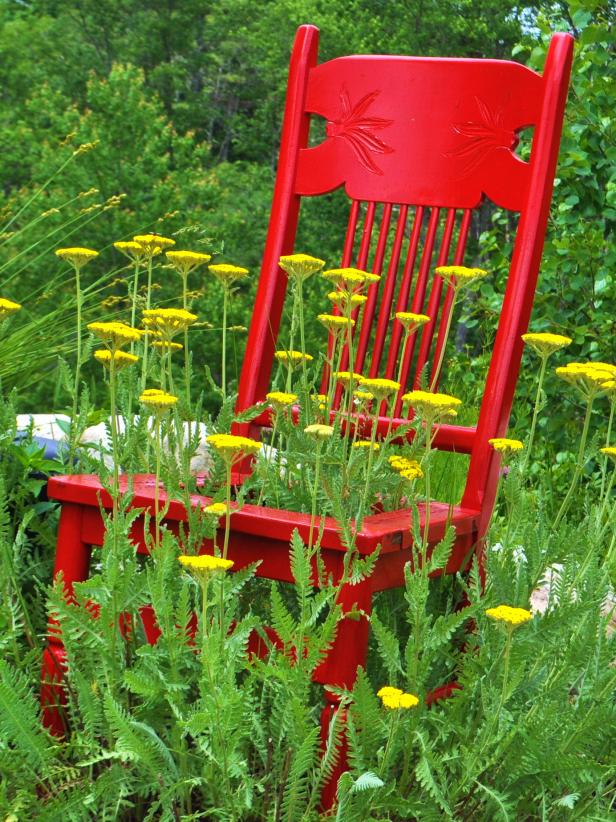
Yarrow flowers balance atop tall stems that float above fern-like leaves.
The other consideration for planting yarrow is soil type. Select a spot where soil is average to lean. Too-rich soil or soil with high fertility leads to lush plants with weak, floppy flower stems. Avoid heavy clay soils, which don't drain well, or you risk rotting plants.
Growing Yarrow
Growing Yarrow From Seed
Growing yarrow seeds is a fun and rewarding garden project. These pretty perennials flower the first year when grown from seed, so you'll enjoy some color right away in your garden. Yarrow seeds provide an economical alternative when you need many yarrow plants to fill in a garden bed.

ProvenWinners.com
Achillea ‘Firefly Peach Sky’ is a drought tolerant perennial that's hardy in Zones 3-8 and takes full sun. Expect plants to grow 28 to 32 inches tall with a 28- to 32-inch spread.
When sowing yarrow seed, start seeds before the growing season indoors or sow them directly into planting areas. For direct sowing outdoors, plant yarrow seeds in late fall in mild winter regions or in early spring as soon as the soil can be worked in cold winter zones. Tackle indoors starting eight to 10 weeks before you intend to tuck seedlings into the garden.
Yarrow seeds need a cold period prior to planting. This process of providing cold is known as stratification. Ideally, yarrow seeds need a month-long stratification window. To achieve this indoors, store seeds in the refrigerator for a month. Place seeds in a damp paper towel tucked into a plastic zipper bag or in damp sand.
Or stratify seeds outdoors using winter sowing techniques. With this method, you plant yarrow seeds in containers outdoors in late fall. Winter sowing gives yarrow seeds the cold treatment they need and seeds sprout when spring air begins to warm soil.

National Gardening Association
Native wildflower yarrow opens white blooms that are sometimes tinged gray or possibly pink at higher elevations. The native yarrow is the one that spreads most aggressively.
Plant yarrow seed in a commercial seed starting mix. Barely cover seeds with just one-quarter inch of soil at most. Yarrow seeds need some light to germinate.
Yarrow seeds are slow to germinate. If you keep soil temperature at 70 degreees, germination should occur within 14 to 28 days. At lower soil temperatures, it can take as a long as 100 days for yarrow seeds to sprout.
Once you're successfully growing yarrow in your garden, it's easiest to take divisions from established plants to start new plants. With this method, you skip sowing and waiting for yarrow seeds to germinate.
Tips for Growing Yarrow Seed
Look for yarrow seeds from reputable seed sources. Yarrow cross pollinates easily, which means that seed may yield the same plant as the parent — or not, especially if any wild common yarrow (Achillea millefolium) grows nearby. If you want seeds to yield a specific, single color, focus on reputable seed companies as your primary source.
Many seeds come as a mix. That means they yield yarrow flowers in a mix of colors. Examples include 'Colorado Mix', 'Summer Berries' mix and 'Summer Pastels' mix. With these seeds, your yarrow plants will open blooms in a variety of colors. Over time, if you let plants set seed and self-sow in the garden, the proportion of colors may vary and shift with the genetically dominant hue becoming more prominent.
Deadheading Yarrow
Growing yarrow is one of the more undemanding chores you'll tackle in gardening. Plants don't need much attention during the growing season.
Some gardeners prune dead flowers to encourage a second set of blooms to form right away. Others clip spent flower stalks back to the leafy base of plants. This results in a fresh flush of leafy growth, followed by a few fall flowers, especially in warmer regions. Fernleaf yarrow doesn't rebloom.
Common yarrow spreads by self-sowing and underground stems. Self-sowing is easy to control — simply snip spent blooms. It's important to remove spent flowers in yarrow varieties and hybrids to prevent plants from reverting to the parent form. This happens because this group of plants readily cross breeds.
Curtailing Spread
Common yarrow and some varieties spread by underground stems. Left alone, plants can easily take over a garden bed. To control yarrow spread, simply pull up new sprouts — and the attached stem, which is just below the soil surface — as they wander out of bounds. Do this in early spring and occasionally throughout the growing season. It's easier to pull up spreading stems after a rain, when soil is soft.
Fernleaf yarrow and some of the common yarrow hybrids don't spread as aggressively as the wild, common type.
Yarrow Varieties
Most yarrow varieties are hardy to Zone 3 and usually flower during high summer over a period of four to six weeks or more. Watch for blooms to open after roses kick out their first flush of blooms and before Russian sage starts. No matter their parentage, yarrow varieties unfurl beautiful, fern-like foliage. The finely divided leaves give the plants good looks whether or not flowers are present.

A pink achillea variety pairs beautifully with pink Asiatic lilies.
Yarrow colors encompass much of the rainbow. The true native species is white yarrow (Achillea millefolium), which opens flowers from white to gray. Common white yarrow is a vigorous, truly robust plant that stands up to heat, drought, winter cold and lean soil.
Plant breeders have used common white yarrow to birth a host of amazing yarrow colors. Look for some of these popular yarrow varieties.
- 'Paprika' — Orange-red flowers with yellow centers
- 'Terracotta' — Rusty orange blooms
- 'Fire King' — Rich red blossoms
- 'Appleblossom' — Pale lilac blooms with white centers
- 'Christel '— Bright magenta pink flowers
- 'Pink Grapefruit' — Clear pink blossoms
- 'Summer Pastels' mix — A variety of other bloom colors, including salmon, cream, apricot and lavender
- 'Colorado' — Created to withstand the intense heat of higher elevations. Flower colors include yellow, red, white and pink.
- 'Coronation Gold' — Type of fernleaf yarrow with gold blooms introduced in 1952 to honor Queen Elizabeth II.
Using Yarrow in the Landscape
- Xeriscape garden. Established clumps of common yarrow are drought-tolerant. They make a great addition to xeriscape garden designs or water-wise landscapes.
- Butterfly garden. Include common yarrow in butterfly gardens. The flat flowerheads comprised of many tiny blooms are the perfect pollinator magnet.
- Cutting garden. Cut yarrow flowers last three to five days in a vase. Gather flowers just as the last flower buds on the flat head have opened but before any blooms have started to fade. Flowers can also be dried.
- Seaside garden. Common yarrow and some varieties tolerate salt, making it a good choice for gardens near the ocean.

Evelyn J. Hadden
A hellstrip is a great place for a xeric, or water-wise, garden, says Evelyn J. Hadden, author of "Hellstrip Gardening" (April 2014, Timber Press). This Evanston, Wyo., border features yarrow varieties (Achillea millefolium).









